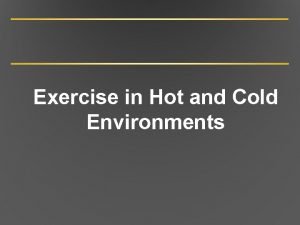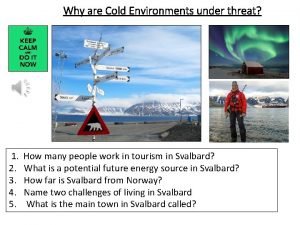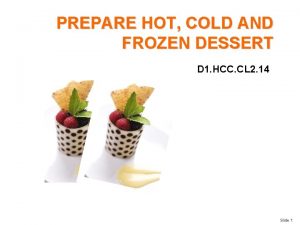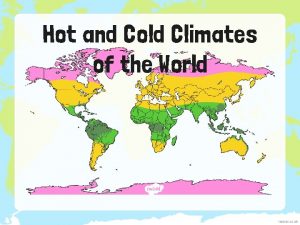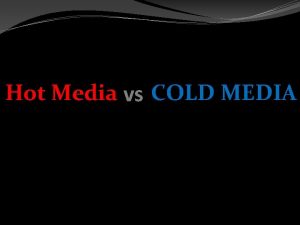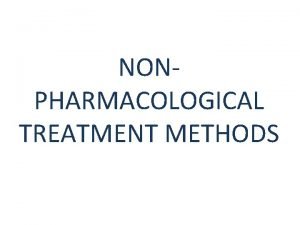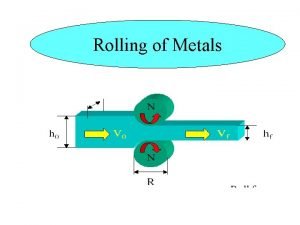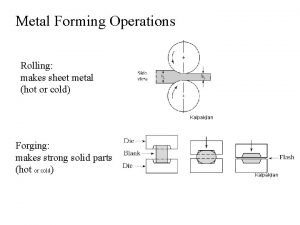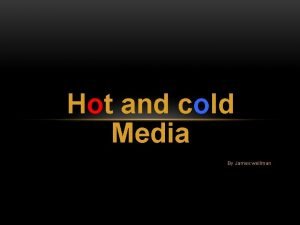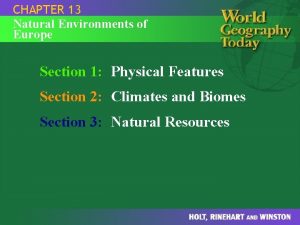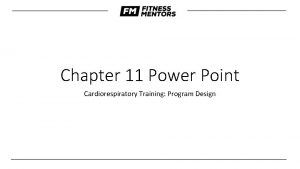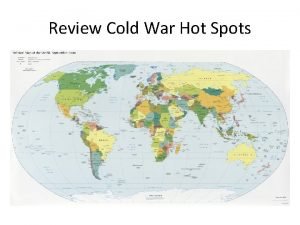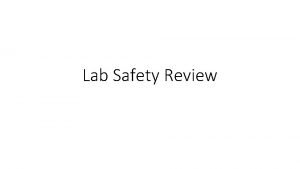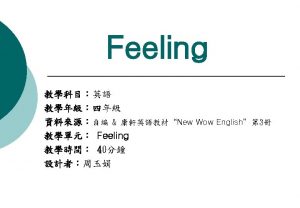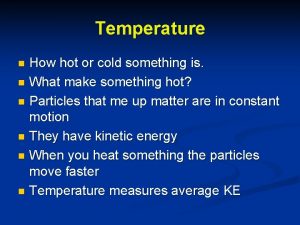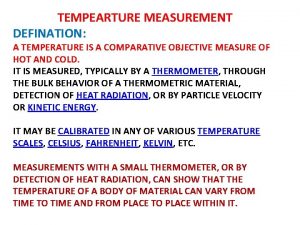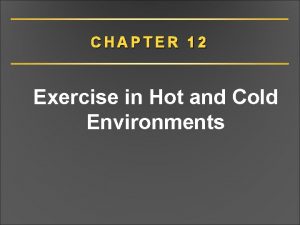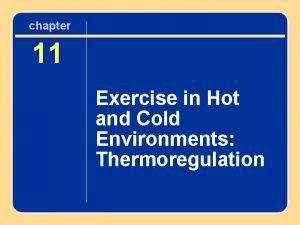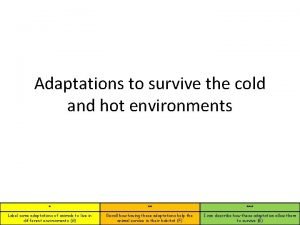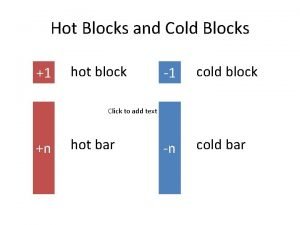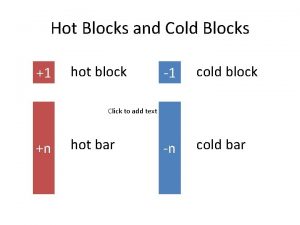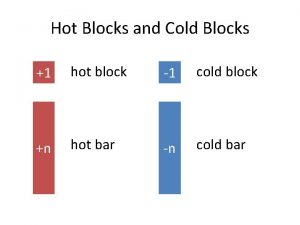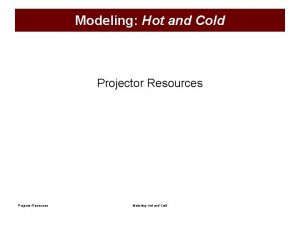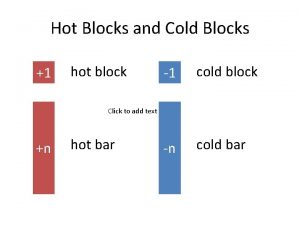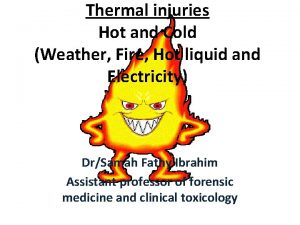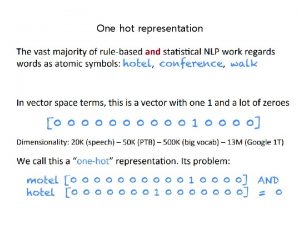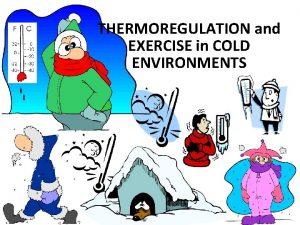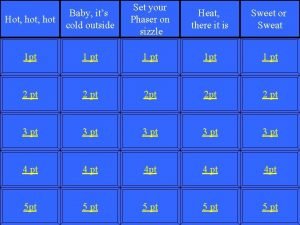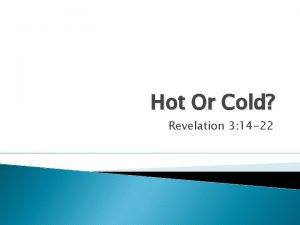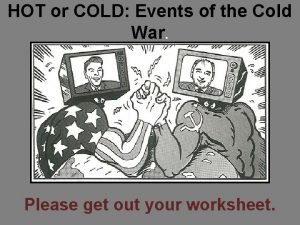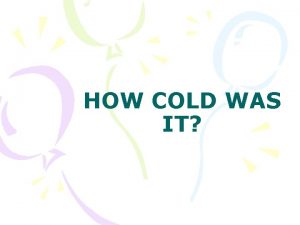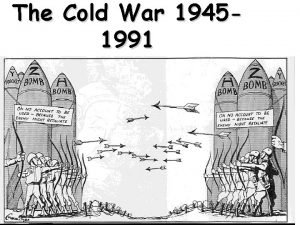CHAPTER 12 Exercise in Hot and Cold Environments




























- Slides: 28

CHAPTER 12 Exercise in Hot and Cold Environments

Body Temperature Regulation • Stress of physical exertion complicated by environmental thermal conditions • Humans are homeothermic – Internal body temperature regulated, nearly constant despite environmental temperature changes – Thermoregulation: regulation of body temperature around a physiological set point

Body Temperature Regulation: Metabolic Heat Production • Metabolic heat production (M) – <25% ATP breakdown cellular work (W) – >75% ATP breakdown metabolic heat • Transfer of heat between body and environment – Heat moves from body core to body shell via blood – When heat reaches skin, can be dissipated by conduction, convection, radiation, or evaporation

Figure 12. 1

Body Temperature Regulation: Transfer of Body Heat • Conduction (K) – Heat transfer from one solid material to another through direct molecular contact (negligible) – Sitting on chilly (or hot) metal bleachers • Convection (C) – Heat transfer by movement of gas or liquid across a surface – Movement across skin surface heat exchange – Major daily thermoregulatory factor

Body Temperature Regulation: Transfer of Body Heat • Radiation (R) – Heat loss in form of infrared rays – Body can give off or receive radiant heat – Major daily thermoregulatory factor • C + K + R = avenues of dry heat exchange – Insulation (I): resistance to dry heat exchange – Still layer of air ideal insulator

Body Temperature Regulation: Thermoregulatory Control • If C and E unlimited, can withstand 200 °C • Briefly withstand core temperatures <35 °C, >41 °C • For normal ranges of body and air temperature, thermoregulatory responses very effective – Core temperature regulated around 37 °C – Core temperature >40 °C inhibits physiological function – Thermoregulatory function controlled by hypothalamus

Physiological Responses to Exercise in the Heat • Exercise M heat load, disturbs thermal homeostasis in most environments • Effects on cardiovascular function – Skin arterioles VD to C heat loss, requires blood flow compared to exercise in the cold – POAH triggers SNS: cardiac output further via HR/contractility, VC to nonessential tissues – Blood volume (sweat), SV can’t (blood pooling), so HR further to compensate (cardiovascular drift)

Physiological Responses to Exercise in the Heat • Limitation: cardiovascular system overload – Heart cannot provide sufficient blood flow to both exercising muscle and skin – Impaired performance, risk of overheating – Especially in untrained or nonacclimated athletes • Limitation: critical temperature theory – Brain shuts down exercise at ~40 to 41 °C – Helps to explain limitations in trained, wellacclimated athletes

Figure 12. 6 a

Figure 12. 6 b

Figure 12. 6 c

Figure 12. 6 d

Physiological Responses to Exercise in the Heat: Fluid Balance • Sweating – Hot environmental temperatures > skin, core temperatures – C, K, R heat gain, E only avenue of heat loss – Eccrine sweat glands controlled by POAH • Sweat electrolyte content < plasma – Duct reabsorbs some Na+, Cl– Light sweating: very dilute sweat – Heavy sweating: less dilute (more Na+, Cl- loss)

Physiological Responses to Exercise in the Heat: Fluid Balance • Training affects sweat composition – More sensitive to aldosterone – Reabsorb (i. e. , conserve) more Na+, Cl– K+, Ca 2+, Mg 2+ losses unchanged • Sweat losses during exercise – Can lose 1. 6 to 2. 0 L (2. 5 -3. 2% body weight) each hour – Sweating blood volume cardiac output – Severe dehydration onset of heat-related illness

Physiological Responses to Exercise in the Heat: Fluid Balance • Exercise and body water loss stimulate adrenal cortex and posterior pituitary gland • Hormonal control of fluid balance – Loss of water, electrolytes triggers release of aldosterone and antidiuretic hormone (ADH) – Aldosterone: retains Na+ at kidneys – ADH (vasopressin): retains water at kidneys

Health Risks During Exercise in the Heat • Six risk factors must be considered – – – Metabolic heat production Air temperature Ambient water vapor pressure (humidity) Air velocity Radiant heat sources Clothing • All factors influence degree of heat stress

Health Risks: Heat Cramps • Least serious of three heat illnesses • Severe, painful cramping of large muscles • Triggered by Na+ losses, dehydration • Most common in heavy sweaters • Prevented by liberal Na+, water intake

Health Risks: Heat Exhaustion • Accompanied by fatigue; dizziness; nausea; vomiting; fainting; weak, rapid pulse • Caused by severe dehydration from sweating • Simultaneous blood flow needs of muscle and skin not met due to low blood volume • Thermoregulatory mechanisms functional but overwhelmed

Health Risks: Heatstroke • Life threatening, most dangerous • Thermoregulatory mechanism failure • Characterized by – Core temp >40 °C – Confusion, disorientation, unconsciousness • If untreated, results in coma and death • Must cool whole body ASAP (e. g. , ice bath)

Figure 12. 9

Health Risks: Preventing Hyperthermia • No outdoor activities when WBGT >28 °C • Schedule practice early morning or evening • Never restrict fluid intake – Fluids readily available to replace sweat losses – Drink breaks every 15 to 30 min – Minimizes rise in HR, core temperature • Minimize clothing (especially football players)

Figure 12. 10

Nutrition and Sport: Sport Drinks • Na+ concentration: aids rehydration – – Glucose and Na+ stimulate water absorption Na+ thirst and palatability Na+ retention promotes water retention 20 to 60 mmol/L • What works best? – Light flavor, no strong aftertaste – Taste, composition ad libitum consumption

Nutrition and Sport: Sport Drinks • Composition of sport drinks – Water + energy (CHO) + electrolytes – Widespread performance benefits • CHO concentration: energy delivery – CHO content slows gastric emptying – Most drinks have 6 to 8 g CHO per 100 ml fluid – Mostly glucose, glucose polymers

Acclimation to Exercise in the Heat • Repeated exercise in heat rapid changes for better performance in hot conditions – Acclimation: short term (9 -14 days) – Acclimatization: long term (months/years) • Effects of acclimation – Cardiovascular function optimized – Sweating rate, sweat distribution, and sweat content change – Results in a lower core temperature during exercise

Acclimation to Exercise in the Heat • Plasma volume due to oncotic P – Temporary (back to normal after 10 days) – Buys time for other adaptations to occur • Heart rate, cardiac output – Supports skin blood flow – Greater heat loss, core temperature • Widespread sweating earlier, more dilute – Prevents dangerous Na+ loss – Optimized E heat loss

Figure 12. 11
 Exercise in hot and cold environments
Exercise in hot and cold environments Why are cold environments under threat
Why are cold environments under threat Types of cold sandwiches
Types of cold sandwiches Hot and cold dessert ppt
Hot and cold dessert ppt Hot and cold media
Hot and cold media Hot and cold world map
Hot and cold world map Hot working and cold working difference
Hot working and cold working difference Cold working processes
Cold working processes Hot media and cold media
Hot media and cold media Differentiate between hot working and cold working
Differentiate between hot working and cold working Proses hot working
Proses hot working Hot and cold application
Hot and cold application Luhan hot
Luhan hot Objectives in making sandwich
Objectives in making sandwich Hot rolling
Hot rolling Hot rolling
Hot rolling Hot
Hot Chapter 13 natural environments of europe
Chapter 13 natural environments of europe Chapter 13 natural environments of europe
Chapter 13 natural environments of europe World geography
World geography How exercise outdoors cold
How exercise outdoors cold Welcome 1 unit 10 lesson 1
Welcome 1 unit 10 lesson 1 Cold war hot spots
Cold war hot spots Hot cold empathy gap
Hot cold empathy gap If acid is splashed on your skin wash at once with
If acid is splashed on your skin wash at once with Happy sad hungry
Happy sad hungry How hot or cold something is
How hot or cold something is Defination of temperature
Defination of temperature Hot site cold site warm site disaster recovery
Hot site cold site warm site disaster recovery
